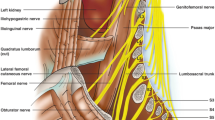Abstract
Wiltse has described in 1968 an intermuscular lumbar approach with two vertical incisions made at 30 mm each on both sides of the midline. Since 1988, Wiltse recommends to practice a single median incision because of aesthetic arguments and because it avoids potential difficulties in case of iterative surgery. In this paper, the goal of authors was to determine the advantages of two lateral incisions, particularly in term of cutaneous vascularization. This cadaveric study concerned ten specimens. Colored latex was injected into the lumbar segmentary arteries before taking a cutaneous flap. We calculated the mean of the number of vessels injected and cut on the midline, then all the 10 mm on both sides. The goal was to establish a cutaneous cartography, and to determine a zone of less vascular sacrifice. The lumbar skin was vascularized by an arteriolar network which spreads out from the midline. At 30 mm from the midline, the number of cut vessels is statistically less than in the others areas (P < 0.05). At this distance, the small arteries are superficial, fine, and the subcutaneous tissue appears poorly vascularized. The two lateral incisions have the advantage compared to a single median incision of being short, and of allowing a direct access to the muscular plan of cleavage without subcutaneous detachment, with a less pressure retraction. We think that an incision at 30 mm from spinous processes is less noxious for the skin because it is located at the border of two vascular territories, which depend of a median network for one, and a lateral network for the other. These incisions generate technical difficulties, however, when the approach is prolonged with the top of L2/L3, when a lateral and/or central canalar decompression is considered, and finally, in the event of iterative surgery.


Similar content being viewed by others
References
Kato H, Hasegawa M, Takada T, Torii S (1999) The lumbar artery perforator based island flap: anatomical study and case reports. Br J Plast Surg 52(7):541–546
Salmon M (1936) Les artères de la peau. Etude Anatomique et Chirurgicale; 114. Masson, Paris. http://www.anato.info/Salmon.htm
Wiltse LL, Spencer CW (1988) New uses and refinements of the paraspinal approach to the lumbar spine. Spine 13(6):696–706
Wiltse LL, Bateman JG, Hutchinson RH, Nelson WE (1968) The paraspinal sacrospinalis-splitting approach to the lumbar spine. J Bone Joint Surg 50(A):119–124
Acknowledgments
Great thanks to B. Belloncle for his technical assistance
Author information
Authors and Affiliations
Corresponding author
Rights and permissions
About this article
Cite this article
Olivier, E., Beldame, J., Slimane, M.O. et al. Comparison between one midline cutaneous incision and two lateral incisions in the lumbar paraspinal approach by Wiltse: a cadaver study. Surg Radiol Anat 28, 494–497 (2006). https://doi.org/10.1007/s00276-006-0123-y
Received:
Accepted:
Published:
Issue Date:
DOI: https://doi.org/10.1007/s00276-006-0123-y




